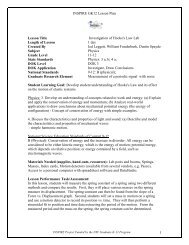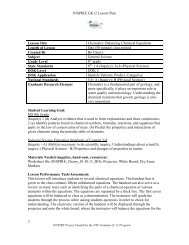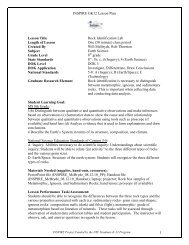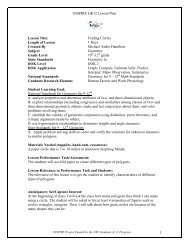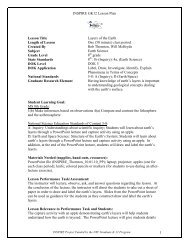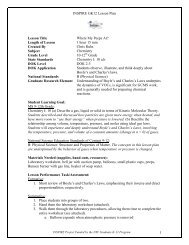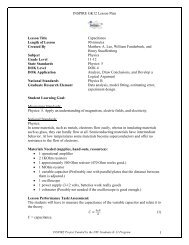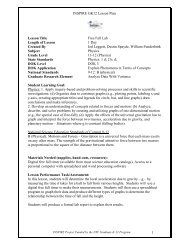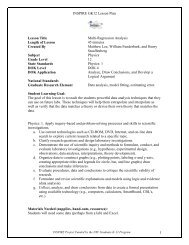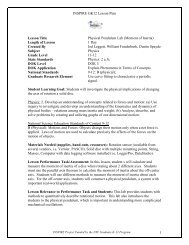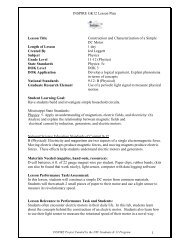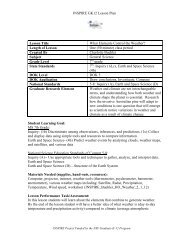INSPIRE GK12 Lesson Plan
INSPIRE GK12 Lesson Plan
INSPIRE GK12 Lesson Plan
You also want an ePaper? Increase the reach of your titles
YUMPU automatically turns print PDFs into web optimized ePapers that Google loves.
<strong>INSPIRE</strong> <strong>GK12</strong> <strong>Lesson</strong> <strong>Plan</strong>a. Cite evidence to summarize the atomic theory. (DOK 1) Models for atoms Building blocks of matter (e.g., proton, neutron, and electron) and elementaryparticles (e.g., positron, mesons, neutrinos, etc.)c. Research the history of the periodic table of the elements and summarize thecontributions which led to the atomic theory. (DOK 2) Contributions of scientists (e.g., John Dalton, J.J. Thomson, Ernest Rutherford,Newton, Einstein, Neils, Bohr, Louis de Broglie, Erwin Schrödinger, etc.) Technology (e.g., x-rays, cathode-ray tubes, spectroscopes) Experiments (e.g., gold-foil, cathode-ray, etc.)d. Utilize the periodic table to predict and explain patterns and drawconclusions about the structure, properties, and organization of matter. (DOK 2) Atomic composition and valence electron configuration (e.g., atomic number, massnumber of protons, neutrons, electrons, isotopes, and ions) Periodic trends using the periodic table (e.g., valence, reactivity, atomic radius) Average atomic mass from isotopic abundance Solids, liquids, and gases Periodic properties of elements (e.g., metal/nonmetal/metalloid behavior,electrical/heat conductivity, electronegativity, electron affinity, ionization energy,atomic/covalent/ionic radius) and how they relate to position in the periodic tableChemistry2. Demonstrate an understanding of the atomic model of matter by explainingatomic structure and chemical bonding.c. Develop a model of atomic and nuclear structure based on theory andknowledge of fundamental particles. (DOK 2)Properties and interactions of the three fundamental particles of the atomLaws of conservation of mass, constant composition, definite proportions, andmultiple proportionsMaterials Needed (supplies, hand-outs, resources): Reference materials (periodic table, internet access, books) Various materials for students to construct their tiles (glue, scissors, coloredpaper, glitter, paint, etc.) Paper (11” x 17” or chosen size) Computer (for students to complete their powerpoint) "Elliott's" Elements Grade Sheet "Elliott's" Elements Presentation Rubric "Elliott's" Elements Presentation Score Sheet<strong>INSPIRE</strong> Project Funded by the NSF Graduate K-12 Program 2



